|

The Kebayan community later was divided
into Kebayan and Uway. The Uway community, led by Siyup Umaw,
migrated out of the mountain and settled at Qauan of Xiulin Township
in Hualien County. Part of the Kebayan community also moved out of
the mountain to Truku, Gulu, Daolas, and Jiashan in the same
Township.
The remaining population of Kebayan
increased over the years. Later, led by the head chief of Lausi
Pakul, they moved to the current site of the Jian Ching Village and
remained there since then. [up]

Kebayan Area situated at the plateau
below Central Cross-Island Highway New Aspen Station (Tai-8 143 km
mark). It is a mountain region of the Liwu River's branch Siaowa
Hei-er River and Luweng River. To the east of the Kybayan area is
the Mantou Mt.; to its west is the Central Mountains. The Awi
family's residence is primarily on versants near the Kebayan area. [up]

Awi originally lived in Saso (now
Chingguan of Nantou County Ren-ai Township Ching). He had three sons
and a daughter. His daughter was called Bonga; after the death of
her husband and unwilling to stay in her husband's home, she
returned to Awi.
Before long, she and her brother Lausi
and Pixo all agreed that, in order to solve the problem of
insufficiency of arable, Lausi should become the leader of migration
and move to a fertile area. They settled in a place now called “Shinbaiyang”,
which became the base of the Awi family's early development of
uncultivated land.
Ulay situates in the southern west of
now Shinbaiyang area, at the slopes of the river bank of where Liwu
River and Luweng River converges. Surrounded by rivers from three
directions, and faced with a mountain at the forth, Ulay is an
advantageous location which is easy to defend, and thus a safe place
for residence. When passed on to the second generation, Ulay no
longer had enough arable for the increased population, thus the
tribe started to migrate to nearby places.
At the beginning, Payan, a son of Bonga,
migrated to a terrace 1 km east of Ulay, and founded a new
community. Payan was brave and strong, as well as benevolent, and
was widely respected. As a result, after his death people call the
place where he lived “Skobayan” for memorial. Later its
pronunciation changed a bit (Kebayan), and became “Shinbaiyang” now.
[up]
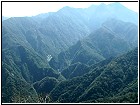 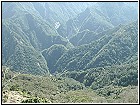 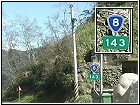 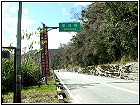
Central Cross-island
Highway Sinbaiyang stop
(Central Cross-island
Highway, Tai No.8, 143km
mark)Tableland under
central cross-island
highway
Liwu River tribal
distribution chart


【The students Painting】
Jian
Ching Village (Miharasi) belongs to Hualien County Wanrong Township,
situated in the north of Wanrong Township, the area of the whole
village is about 640.9724 hectares. It is an aboriginal village
beside a mountain.
This village has two parts: one near
Jianching Police Station, the other at the foot of Fenglin Mt. To
the west of the village is the Central Mountains; whereas the part
that is closest to Jianching's small hills is Pinglin Mt. To the
east of the village is Fenglin Township Nanping Neighborhood, north
Chingshui River, and abut upon Wanrong Township Silin Village and
Fenglin Township Lirong Neighborhood. Chingshui River originated
from Central Mountains; it runs through Jianching, Nanping, and
Beilin, and converges to Hualien River.[up]
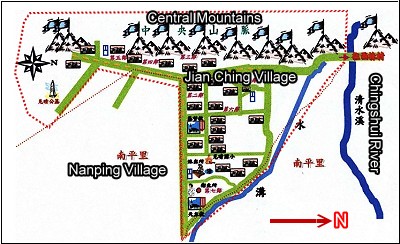
Chingshui River bevels the valley. The
stream is very clear and pure. The pureness allows visitors to play
in it. Visitors could also experience the luxury of forest bath
around the stream. Despite its poor connection with the outbound
traffic, it still attracts many neighborhood residents. It could be
said that Chingshui River still keeps its original features and is
natural for a recreation area.
Industrial road is the main inbound transportation; Hua-tung highway
(Tai No. 9) is the main outbound transportation. The east side of
Chienching Village connects to the Lingnanping Township, and the
south side of it connects to the Fengyi Township (Fenglin Mt.).
Residents visit Fenglin Township the most often because they usually
pass through it by motorcycles or cars via Tai-Chiu Line. The
commute is around ten to twenty minutes.
Another route— Hua-tung highway, is
more suitable for the distance travel. If visitors want to travel to
Hualien or to Taitung, they can get a transfer at Nanping Train
station. But be sure to know that there are more trains running at
Fenglin Train Station, so the time table is more flexible there.
If you have friends coming from Hualien
who want to visit Chienching Village, they could take southbound
buses or southbound trains to Fenglin Township and turn west at a
small alley (turn right at the highway). After a five to ten minutes
walk, they will arrive at Chienching Village. [up]


Jian Ching community has many studios
of traditional arts. Owner of these studios are all enthusiastic in
traditional handicrafts. Not only do they preserve the traditional
skill, they also try to promote the traditional culture. Classes on
traditional culture in the school depend on the knowledge of these
professional craftsmen.
1. Uhai Studio:
Owner: Ce-mei Hu (Uhai)
Introduction: Specialized in the craftsmanship of Truku traditional
weaving and rattan tools; expert in traditional weaving.
2. Iyang Studio:
Owner: Hui-fang Wu Chung (Iyang)
Introduction: Specialized in the craftsmanship of Truku traditional
weaving and rattan tools; expert in traditional weaving.
3. Uma Leather Carving
Studio:
Owner: Uma
Introduction: Their leather productions integrated cultures of
various tribes. Works blended with tote
4. Guang Nan Bow & Arrow
Studio:
Owner: Guang-nan He
Introduction: Specialized in hand-made traditional Truku bows and
arrows, provides archery fans from inside and outside the township
for practical use or collection. In order to keep the quality of
their products high, their amounts are limited and must be reserved.
5. Simple Ramie Back
Basket:
Owner: Rong-fa Li, Jin-de Chiang
Introduction: The Simple Ramie Back Baskets they produced are
characteristic. [up]


References and Source:
1.“Mountains and Waters of Jianqing”, Alang Miharasi Native Studies
Program Unit 2, Jianqing Elementary School
2.
Hualien County Wanrong Township website—Office Introduction—Village
Office—Jianching Village (2008.02.03)
http://www.wanrung.gov.tw/officesintro/village_jc.aspx |

